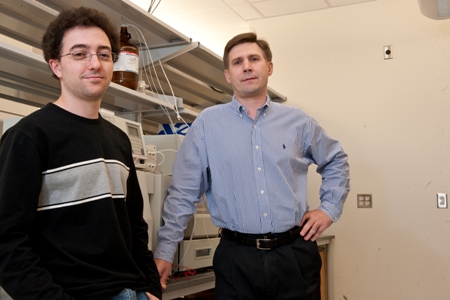A Research team led by Eugene Zubarev, Rice University’s Associate Professor of chemistry, has developed a method to pack over 2 million gold nanorods inside a single cancer cell, paving the way to accelerate the advancements of cancer therapies, whereupon nanorods will be utilized as minute heaters to cook cancer cells from the inside.
 Rice University's Leonid Vigderman (left) and Eugene Zubarev have found a way to load more than 2 million tiny gold particles called nanorods into a single cancer cell. (CREDIT: Jeff Fitlow/Rice University)
Rice University's Leonid Vigderman (left) and Eugene Zubarev have found a way to load more than 2 million tiny gold particles called nanorods into a single cancer cell. (CREDIT: Jeff Fitlow/Rice University)
Zubarev stated that the loaded gold nanorods have increased the weight of the breast cancer cells by an average of around 13%, but surprisingly, all the cells have performed their normal functions even in the presence of the gold nanoparticles. The nanorods become lethal to the cancer cells, when they have been activated by a laser, Zubarev said.
The gold nanorods can capture and transform the non-disruptive light into heat. However, more number of gold nanorods is required to destroy a cell, as each of them emits only small amount of heat. The irradiation time and power level can be set to a low level if more number of gold nanorods can be packed within the cell, Zubarev said. However, researchers have been struggling to load more number of nanoparticles into a living cell.
Rice chemists cram 2 million nanorods into a single cancer cell.
Gold nanorods do not dissolve in a solution, as they are pure gold. Cetyltrimethylammonium bromide (CTAB) has been used to make an aqueous solution of gold nanorods. CTAB-coated nanorods’ surfaces have a positive charge, which makes cells to consume them. However, due to the toxicity of CTAB, it is not suitable for biomedical applications.
To overcome this problem, the Rice University researchers have used MTAB in place of CTAB. MTAB has two more atoms, one hydrogen atom and one sulfur atom, bonded at one end. These additional atoms enable MTAB to create a stable chemical bond with nanorods. On the contrary, the bond between CTAB and nanorods is weak, which makes CTAB to seep out into the neighboring area, causing the toxicity of CTAB-coated nanorods.
The Rice University research team has spent several years to design the optimal strategy for the synthesis of MTAB as a replacement of CTAB. Morever, the team has developed a purification technique to eliminate all CTAB traces from the nanorod solution.